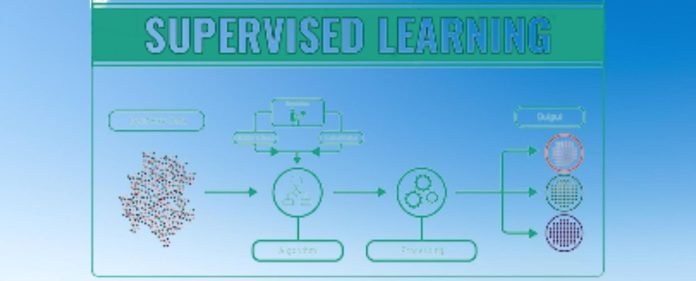In the dynamic landscape of machine learning, few paradigms have been as transformative as supervised learning. This foundational approach has reshaped industries by enabling machines to learn from labeled data, effectively equipping them with the capability to make intelligent predictions and decisions. This comprehensive article delves deeply into the intricate world of supervised learning, elucidating its core principles, real-world applications across various domains, and its pivotal role in shaping the future of technology-driven, data-centric decision-making.
Understanding Supervised Learning
A Stepping Stone to Intelligence Supervised learning, at its essence, is a machine learning technique in which algorithms learn from a labeled dataset. This dataset consists of input data intricately paired with corresponding output labels, creating a tandem of correct answers. The algorithm then harnesses this labeled dataset to decipher overarching patterns and relationships, culminating in the algorithm’s capacity to offer accurate predictions for new, unseen data. The essence of “supervision” lies in endowing the algorithm with precise answers during its training phase, which, in turn, cultivates the algorithm’s ability to learn and refine its predictive prowess over time.
Critical Concepts of Supervised Learning: The Building Blocks
The essential concepts of supervised learning involve using labeled data to train a model to make predictions on new, unseen data. This process involves selecting an appropriate algorithm, defining the features or inputs, and choosing the proper performance metric to evaluate the model’s accuracy.
- Input Features: These represent the attributes or distinct characteristics of the data, providing the model with essential information to formulate predictions. In image recognition, for instance, these features could encapsulate pixel values.
- Output Labels: These encapsulate the correct answers corresponding to the input data. In classification tasks, these labels correspond to specific categories assigned to the data.
- Training Data: This encompasses labeled examples that the model utilizes for its training process, facilitating the learning of relationships between input features and output labels.
- Prediction: Post-training, the model leverages the discerned patterns to predict output labels for novel and previously unseen data.
- Loss Function: This metric gauges the degree of alignment between the model’s predictions and the actual labels. The ultimate objective is to minimize this loss during the training phase.
Real-World Applications: Where Supervised Learning Shines
Real-world applications of supervised learning are vast and varied, ranging from image and speech recognition to fraud detection and personalized recommendations.
- Image Classification: Supervised learning is the backbone of image recognition systems that can identify objects and animals and diagnose medical conditions from images.
- Natural Language Processing (NLP): Language models adeptly trained through supervised learning, power applications like chatbots, sentiment analysis, and language translation, enabling more effective human-computer interaction.
- Healthcare Diagnostics: The healthcare domain benefits immensely from supervised learning, as algorithms analyze medical images (X-rays, MRIs, histopathological slides) to contribute to the accurate diagnosis of diseases.
- Fraud Detection: By scrutinizing historical data for patterns, supervised learning models can effectively identify fraudulent transactions, enhancing financial security.
- Autonomous Vehicles: Supervised learning is pivotal in self-driving vehicles, enabling them to proficiently recognize and respond to objects, pedestrians, and traffic signals.
Challenges and Considerations: Navigating the Path
However, there are also challenges and considerations when implementing supervised learning. One of the biggest challenges is obtaining high-quality labeled data, which can be time-consuming and expensive.
- Data Quality and Quantity: The efficacy of supervised learning hinges on the availability of high-quality labeled data. Inadequate or biased datasets can engender inaccurate predictions.
- Overfitting and Underfitting: The complexity of models can lead to overfitting (overly complex) or underfitting (excessively simple), impacting their capacity to generalize to new data.
- Feature Engineering: The judicious selection and engineering of relevant features are instrumental in model performance. Inadequate feature selection can hinder the learning process.
- Scalability: Training large-scale models on extensive datasets can impose significant computational demands and time constraints.
The Future of Supervised Learning: Pioneering Ahead
As technology advances and more data becomes available, the future of supervised learning looks promising. However, it will require continued attention to ensure that models are accurate, unbiased, and fair and that high-quality labeled data is available.
- Transfer Learning: Harnessing pre-trained models and transposing their acquired knowledge to new tasks will diminish the reliance on extensive labeled data, expediting the learning curve.
- Explainable AI: Endeavors to enhance model interpretability will heighten trust and acceptance, empowering users to comprehend the reasoning behind model decisions.
- Semi-Supervised and Active Learning: The amalgamation of labeled and unlabeled data, coupled with strategies like active learning, will enhance data annotation efficiency and model performance.
- Ethical Considerations: Tackling bias and ensuring fairness within supervised learning models is paramount to prevent the perpetuation of existing inequalities.
Conclusion
Supervised learning is the bedrock of contemporary machine learning, empowering machines to extract insights from data and make astute decisions. Its impact spans myriad domains, reshaping industries and influencing how we interact with technology and data.
As technological strides march forward and ethical considerations underscore the landscape, supervised learning remains at the forefront of the data-driven revolution. It promises a future where intelligent predictions and informed decision-making seamlessly intertwine with our daily lives, ultimately guiding us toward unprecedented innovation and advancement.



